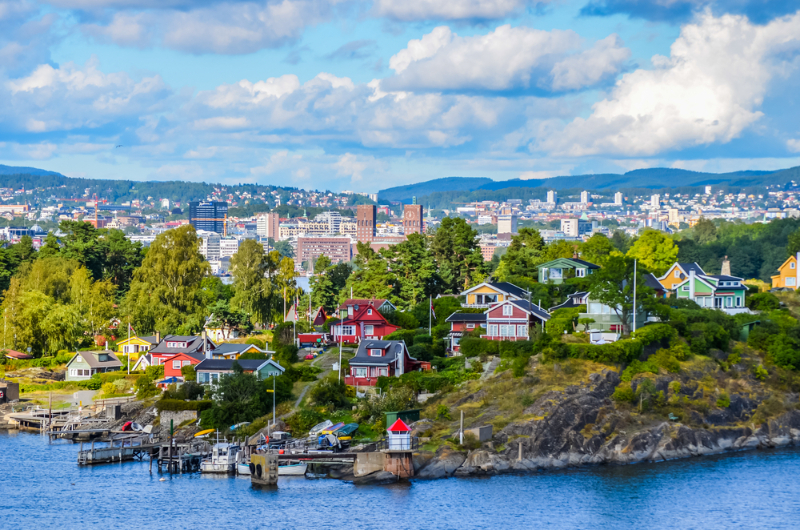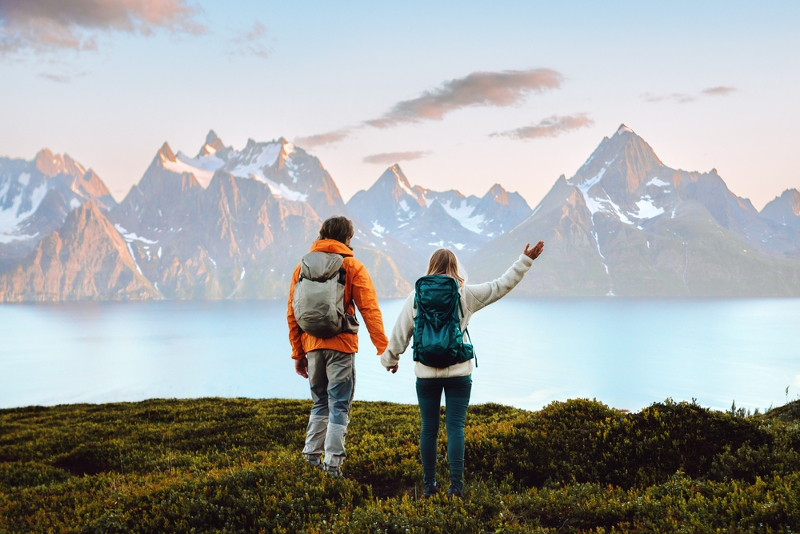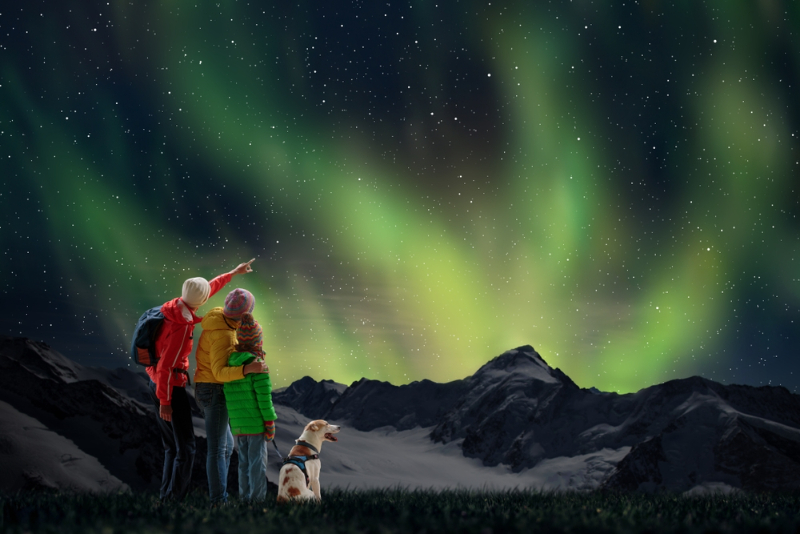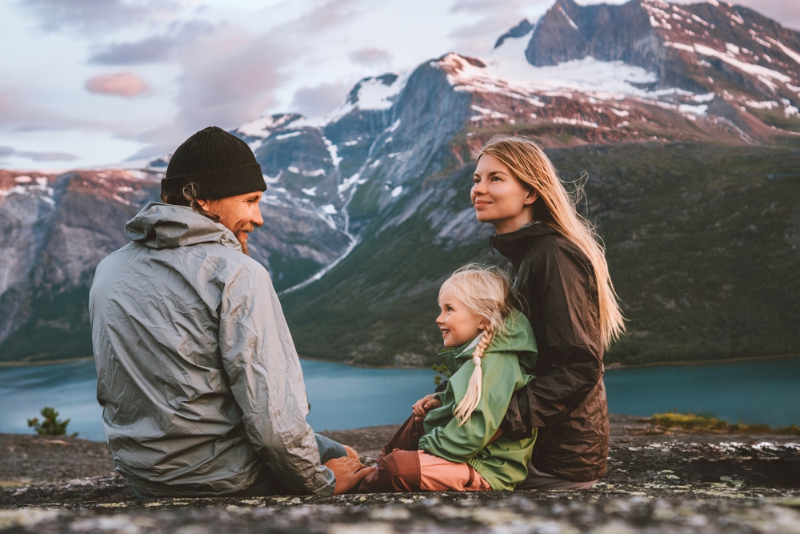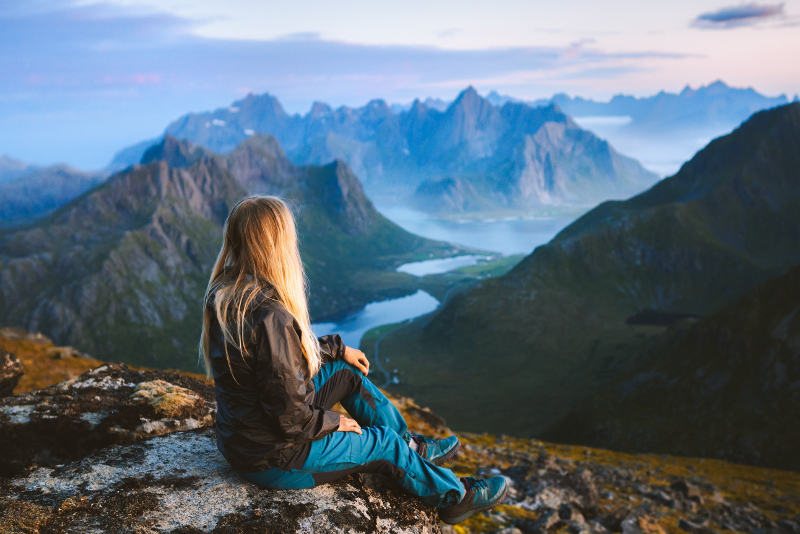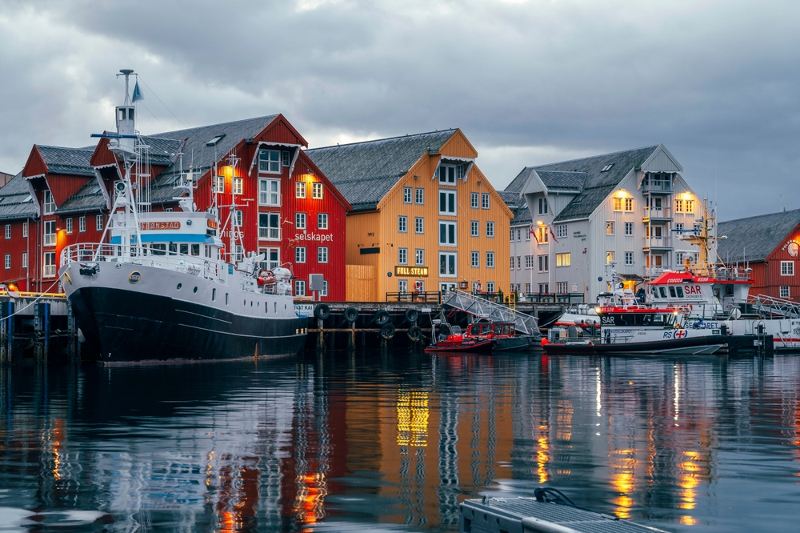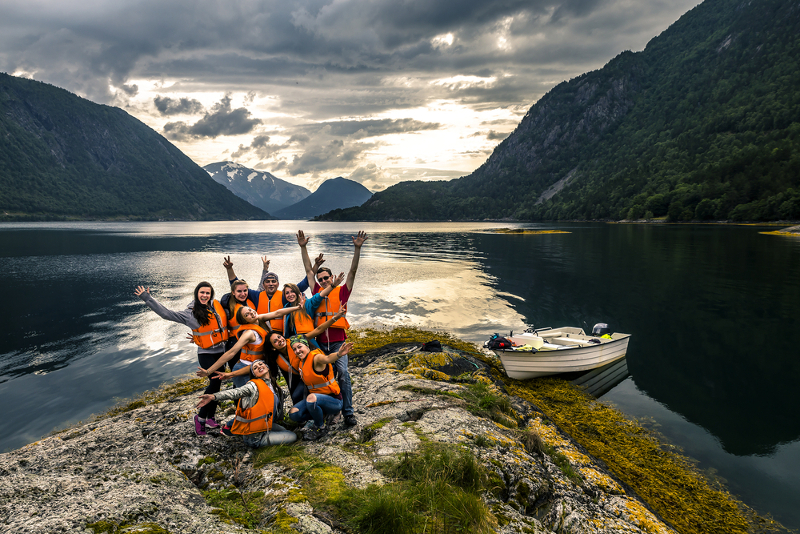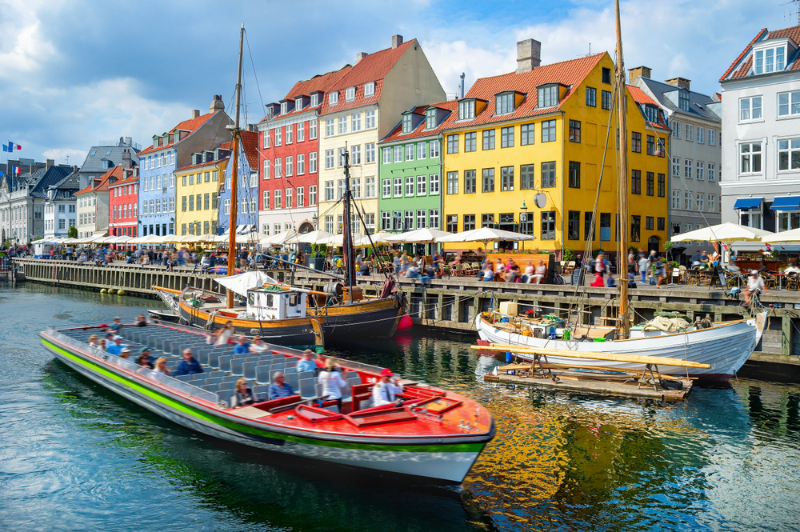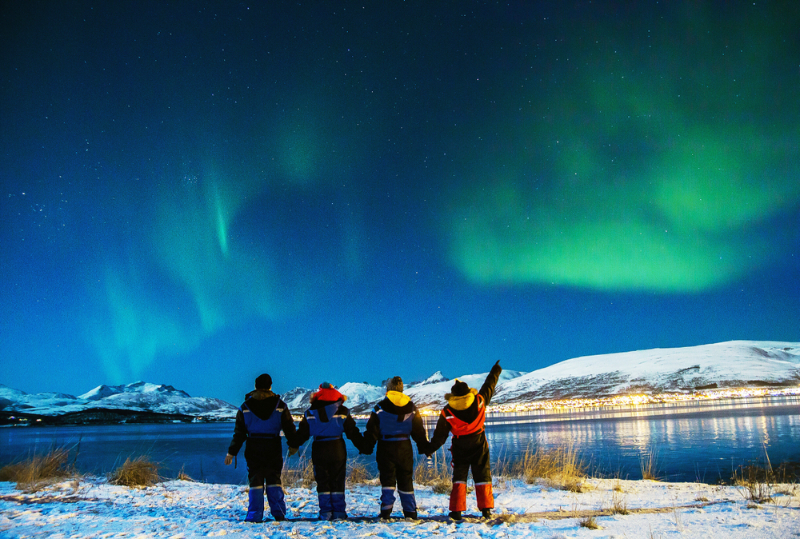A natural occurrence, the northern lights, sometimes called the aurora borealis, are visible in the northern sky during the winter months. To witness them, tourists travel from all over the world to northern latitude nations like Norway. However, for you to be able to see such a lovely phenomena, the stars must, so to speak, align. More information on the natural wonder and how to get ready to view them in Norway can be found in our guide below.
Dancing ribbons of green, purple, and pink illuminate the night sky, creating a magical experience that is both humbling and exhilarating. Norway stands out for its accessibility, well-developed tourism infrastructure, and diverse range of experiences, from guided northern lights Norway tours to unique stays at Norway northern lights hotels.
The sky must be clear, dark, and free of as many city lights as possible in order to observe the northern lights in Norway. As you can see, a lot of things must line up for guests to view the lights. However, that adds to its magic! You will never forget this experience, which is like seeing shape-shifting spirits dance across the heavens.
Dancing ribbons of green, purple, and pink illuminate the night sky, creating a magical experience that is both humbling and exhilarating. Norway stands out for its accessibility, well-developed tourism infrastructure, and diverse range of experiences, from guided northern lights Norway tours to unique stays at Norway northern lights hotels.
The sky must be clear, dark, and free of as many city lights as possible in order to observe the northern lights in Norway. As you can see, a lot of things must line up for guests to view the lights. However, that adds to its magic! You will never forget this experience, which is like seeing shape-shifting spirits dance across the heavens.
Best Time To Visit Norway For Northern Lights

With more hours of darkness during the arctic night, late September to early April are the best time to see northern lights in Norway. But because the solar activity that produces the Northern Lights is stronger in September and March, those months are statistically the best.
Always take into account the hours of light while organizing your journey to see the Northern Lights in Norway because the sky will be too bright to see the lights, even at lower latitudes, if you schedule your trip during the summer.
Early fall or late winter are often the best times to see northern lights in Norway in terms of weather and clouds. Remember that the weather at that latitude is usually unpredictable, and the majority of Norway's best places to watch the aurora are located above the Arctic circle.
Month-wise wise Best time to see Northern Lights in Norway:
September and October: Although there aren't many hours of darkness in September and October, there are more solar activities and less clouds at this time.
November, December, January, and February: The most visited months in Norway during the winter Northern Lights season are November, December, January, and February. The percentage of covered skies is typically higher in some months, such as November.
March and April: Solar activity always peaks around the spring equinox, which typically leads to breathtaking Northern Lights display
What to Pack for Your Trip to Norway for Northern Lights?

In the far north, northern lights Norway excursions take place at night, so it's wise to dress appropriately! Staying dry and comfortable will encourage you to spend more time outside searching for these amazing dancing lights.
Layers: Layering is key, as temperatures can drop well below freezing, especially during Norway northern lights tours. Particularly thermal layers beneath well-insulated outerwear are crucial.
Wool: Wool is a particularly excellent base-layer, and we strongly advise packing (or buying) woolen base-layer shirts and pants. When it comes to Northern Norway's daily (and nightly!) winter expeditions, they will be your best buddy.
Wear gloves: Although some people swear by wearing both gloves and mittens (a combination you may appreciate on cold days!), we particularly advise wearing gloves with divided fingers so you can shoot pictures throughout your nighttime adventure without taking off your mittens.
Layers: Layering is key, as temperatures can drop well below freezing, especially during Norway northern lights tours. Particularly thermal layers beneath well-insulated outerwear are crucial.
Wool: Wool is a particularly excellent base-layer, and we strongly advise packing (or buying) woolen base-layer shirts and pants. When it comes to Northern Norway's daily (and nightly!) winter expeditions, they will be your best buddy.
Wear gloves: Although some people swear by wearing both gloves and mittens (a combination you may appreciate on cold days!), we particularly advise wearing gloves with divided fingers so you can shoot pictures throughout your nighttime adventure without taking off your mittens.
Where to See Northern Lights in Norway?

Tromso: The most well-known location in Norway to view the Northern Lights is Tromso. Great tour deals are often found in Aurora, which has a well-developed tourism industry. Because Tromso is in the northernmost region (69º latitude), the aurora season is shorter than in other places, and there are less hours of darkness throughout the summer. The best time to see the Northern Lights is between late September and early April.
Lofoten Islands: The nicest Norwegian scenery may be seen while seeing the Northern Lights in the Lofoten Islands. Perfect for photographers. These dramatic islands combine stunning scenery with excellent aurora visibility. Stay in traditional fisherman's cabins (rorbuer) and enjoy the coastal beauty
Senja: It has become more well-known as a place to witness the Aurora dancing over the Norwegian fjords in recent years. Even though Senja has long been overlooked due to its location in the shadow of Lofoten, it has recently become a favorite place for Northern Lights photography in Norway. Though less populated than the Lofoten Islands, the scenery is comparable, featuring rocky fjords and charming fishing communities.
Alta: Alta is referred to as the “City of Northern Lights” at 70 degrees latitude since it is one of Norway's most accessible and northernmost locations for Aurora viewing. Some of the top Norway northern lights hotels can even be found here. Sorrisniva, where you can view the Northern Lights from your igloo accommodation, is one of the most well-liked. Although the costs are high, the experience is one of a kind. Your room can be reserved here.
Bodø and Salten: Bodø and the Salten region, just north of the Arctic Circle, offer excellent northern lights experiences with a mild coastal climate and dramatic scenery. Watch the aurora from mountain viewpoints like Rønvikfjellet, beaches along the north side, or venture into the Saltfjellet mountains for even darker skies and unforgettable displays
Svalbard: Norway's northernmost point is situated at a latitude that is ideal for viewing the Northern Lights. Polar bears are another reason for this island's fame. As previously said, polar bears are the main attraction for tourists visiting Svalbard, but snowmobile and Northern Lights tours are also available. Remember that it costs more to travel here than it does in places like Tromso or Lofoten. While the majority of the islands are deserted, some, like Longyearbyen, are populated.
North Cape: One of Norway's most remote yet unique locations to witness the Aurora Borealis is the North Cape. With a latitude of 71º, the North Cape is Norway's northernmost point on the Scandinavian peninsula, making it the ideal destination for those seeking to travel further north to enhance their chances of witnessing the Northern Lights. But remember, it's more costly and more difficult to get here.
Narvik: Narvik, located in northern Norway, is renowned for its stunning mountain landscapes and unique position above the Arctic Circle. It offers excellent opportunities to see the northern lights, especially from the Narvikfjellet mountain. Visitors can combine aurora viewing with winter sports like skiing, making Narvik a versatile Arctic destination.
Lofoten Islands: The nicest Norwegian scenery may be seen while seeing the Northern Lights in the Lofoten Islands. Perfect for photographers. These dramatic islands combine stunning scenery with excellent aurora visibility. Stay in traditional fisherman's cabins (rorbuer) and enjoy the coastal beauty
Senja: It has become more well-known as a place to witness the Aurora dancing over the Norwegian fjords in recent years. Even though Senja has long been overlooked due to its location in the shadow of Lofoten, it has recently become a favorite place for Northern Lights photography in Norway. Though less populated than the Lofoten Islands, the scenery is comparable, featuring rocky fjords and charming fishing communities.
Alta: Alta is referred to as the “City of Northern Lights” at 70 degrees latitude since it is one of Norway's most accessible and northernmost locations for Aurora viewing. Some of the top Norway northern lights hotels can even be found here. Sorrisniva, where you can view the Northern Lights from your igloo accommodation, is one of the most well-liked. Although the costs are high, the experience is one of a kind. Your room can be reserved here.
Bodø and Salten: Bodø and the Salten region, just north of the Arctic Circle, offer excellent northern lights experiences with a mild coastal climate and dramatic scenery. Watch the aurora from mountain viewpoints like Rønvikfjellet, beaches along the north side, or venture into the Saltfjellet mountains for even darker skies and unforgettable displays
Svalbard: Norway's northernmost point is situated at a latitude that is ideal for viewing the Northern Lights. Polar bears are another reason for this island's fame. As previously said, polar bears are the main attraction for tourists visiting Svalbard, but snowmobile and Northern Lights tours are also available. Remember that it costs more to travel here than it does in places like Tromso or Lofoten. While the majority of the islands are deserted, some, like Longyearbyen, are populated.
North Cape: One of Norway's most remote yet unique locations to witness the Aurora Borealis is the North Cape. With a latitude of 71º, the North Cape is Norway's northernmost point on the Scandinavian peninsula, making it the ideal destination for those seeking to travel further north to enhance their chances of witnessing the Northern Lights. But remember, it's more costly and more difficult to get here.
Narvik: Narvik, located in northern Norway, is renowned for its stunning mountain landscapes and unique position above the Arctic Circle. It offers excellent opportunities to see the northern lights, especially from the Narvikfjellet mountain. Visitors can combine aurora viewing with winter sports like skiing, making Narvik a versatile Arctic destination.
How to See Northern Lights in Norway?

To maximize your chances of seeing the aurora, follow these tips:
- Head north, ideally above the Arctic Circle, where aurora activity is strongest.
- Choose nights with clear, cloudless skies and minimal light pollution.
- Use aurora forecast apps to track solar activity and KP index.
- Join a Norway northern lights tour for expert guidance and access to the best viewing spots.
- Be patient and prepared to wait, as the lights can be unpredictable.
Many tours provide thermal suits, hot drinks, and photography assistance, making the experience comfortable and memorable.
How to photograph the Northern Lights?

This winter, are you considering taking your own pictures of the northern lights? Staff at Nordic Visitor have provided these brief advice:
Equipment List:
Equipment List:
- Camera: For optimal results, use an SLR camera with manual focus.
- Tripod: A tripod is absolutely necessary since, even with the most steady hands, a long exposure shot without one will be a jittery, blurry mess.
- Shutter release: Purchase a remote shutter release to avoid touching the camera at all and take even steadier pictures.
- Extra batteries: Batteries tend to run out more quickly in freezing temperatures. It doesn't hurt to pack some snacks to give you extra energy.
- Flashlight or headlamp: It's helpful to see what you're doing because you'll be shooting in extremely cold and dark conditions.
Camera Setting:
- Image stabilisation: Turn off image stabilization if your lens has it.
- ISO: Raise the ISO as much as possible, ideally to 400 or 800. This is a reasonable range to operate within, though it will depend on the particular lens you're using.
- Aperture (f-stop): Reduce the aperture (f-stop) as much as you can. More light will enter the lens as a result of this. This figure can drop to roughly 3.5 on the majority of cameras.
- Shutter speed: Set the shutter speed to 15 to 30 seconds for a lengthy exposure. More light will be collected the longer the exposure.
Where to Stay in Norway for Northern Lights?

Tromso Ice Domes Hotel: Staying far from light pollution is our greatest recommendation for observing the Northern Lights. Therefore, the Tromsø Ice Domes Hotel, which is reconstructed every winter and has Norway Northern Lights igloos, is your best option if you're searching for a decent location to stay in Tromso.
Radisson Blu Hotel: The Radisson Blu Hotel features excellent Nordic design features and first-rate facilities like a restaurant, pub, pizzeria, fitness center, and sauna with city views. This Norway hotel for seeing the Northern Lights is close to several of Tromso's top attractions, such as the Arctic Cathedral and Polar Museum, and is situated directly by Tromso Harbor.
Aurora Camp Tromso: Make reservations at the Aurora Camp in Tromso to have an adventure, witness the aurora, and learn about Sami culture. A warm meal and lodging in a glass-roofed lavvu (traditional Sami tent) are included in this opportunity to camp under the Northern Lights in Norway.
Eliassen Rorbuer: From some of the most well-known Norway Northern Lights cabins, Eliassen Rorbuer, take in the Northern Lights dance over the most breathtaking fjord in the Lofoten Islands. With fully functional kitchens and bathrooms, as well as views of the fjord and mountains, these refurbished fishermen's huts exude rustic appeal.
Reinefjorden Sjøhus: Reinefjorden Sjøhus is yet another amazing Norway northern lights hotel on the Lofoten Islands with views of fjords. Though more contemporary than the classic Eliassen Rorbuer, the cabins and apartments at this Norwegian aurora borealis lodging nevertheless have great views of the Northern Lights. Actually, every room has multiple floor-to-ceiling windows, making them ideal for indoor aurora watching.
Radisson Blu Hotel: The Radisson Blu Hotel features excellent Nordic design features and first-rate facilities like a restaurant, pub, pizzeria, fitness center, and sauna with city views. This Norway hotel for seeing the Northern Lights is close to several of Tromso's top attractions, such as the Arctic Cathedral and Polar Museum, and is situated directly by Tromso Harbor.
Aurora Camp Tromso: Make reservations at the Aurora Camp in Tromso to have an adventure, witness the aurora, and learn about Sami culture. A warm meal and lodging in a glass-roofed lavvu (traditional Sami tent) are included in this opportunity to camp under the Northern Lights in Norway.
Eliassen Rorbuer: From some of the most well-known Norway Northern Lights cabins, Eliassen Rorbuer, take in the Northern Lights dance over the most breathtaking fjord in the Lofoten Islands. With fully functional kitchens and bathrooms, as well as views of the fjord and mountains, these refurbished fishermen's huts exude rustic appeal.
Reinefjorden Sjøhus: Reinefjorden Sjøhus is yet another amazing Norway northern lights hotel on the Lofoten Islands with views of fjords. Though more contemporary than the classic Eliassen Rorbuer, the cabins and apartments at this Norwegian aurora borealis lodging nevertheless have great views of the Northern Lights. Actually, every room has multiple floor-to-ceiling windows, making them ideal for indoor aurora watching.
Want to experience the Northern Lights in style? Discover the best luxury glass igloo stays in our Scandinavia Aurora Lodge Guide
What Other Things to Do on Your Norway Trip?

While chasing the aurora is a highlight, Norway offers a wealth of other experiences:
Fjord Cruises: Explore UNESCO-listed fjords like Geirangerfjord and Nærøyfjord on scenic cruises, often included in popular Norway tours.
Dog Sledding: Glide through snowy landscapes behind a team of huskies—a quintessential Arctic adventure.
Sami Culture: Learn about the indigenous Sami people, try traditional foods, and hear stories around the fire.
Wildlife Safaris: Join whale watching or wildlife tours in places like Vesterålen and Tromsø.
Skiing and Snowshoeing: Enjoy world-class skiing in Narvik or snowshoe hikes under the aurora.
Ice Hotels: Spend a night in an ice hotel for a truly unique Arctic experience.
These activities add depth and excitement to your northern lights Norway journey.
Fjord Cruises: Explore UNESCO-listed fjords like Geirangerfjord and Nærøyfjord on scenic cruises, often included in popular Norway tours.
Dog Sledding: Glide through snowy landscapes behind a team of huskies—a quintessential Arctic adventure.
Sami Culture: Learn about the indigenous Sami people, try traditional foods, and hear stories around the fire.
Wildlife Safaris: Join whale watching or wildlife tours in places like Vesterålen and Tromsø.
Skiing and Snowshoeing: Enjoy world-class skiing in Narvik or snowshoe hikes under the aurora.
Ice Hotels: Spend a night in an ice hotel for a truly unique Arctic experience.
These activities add depth and excitement to your northern lights Norway journey.
Essential Tips for Norway Northern Lights Tours

We've compiled a few useful tips for you if you intend to include a northern lights excursion in your vacation to Northern Norway (or are traveling to Norway just for this reason!):
It's all about timing: Although this phenomenon occurs throughout the year, in the Nordic region, it is most noticeable from October to March (winter).
Examine the forecast: Without the proper combination of clear skies and solar activity, location is meaningless.
Leave town: Dark evenings are obviously necessary, but it's also a great way to escape the bright lights of the city. Your view of the sky will be substantially enhanced with a stay in the countryside or a guided journey into the forest.
Remain up late: The best time to see the northern lights is from 11 p.m. to 2 a.m. In the event that the lights go out, certain rural hotels might provide a unique "wake up" service.
Be Patient: Please be patient as there is no set time for the lights to show. Most northern lights trips include some sort of entertainment or refreshments to keep customers warm and engaged, even if you might have to wait for a few hours. Unfortunately, there is no way to guarantee sightings.
Bundle up: Insulated outerwear and thermal layers are crucial. Coveralls and/or other warm clothing will typically be loaned to you if you're on a guided expedition.
It's all about timing: Although this phenomenon occurs throughout the year, in the Nordic region, it is most noticeable from October to March (winter).
Examine the forecast: Without the proper combination of clear skies and solar activity, location is meaningless.
Leave town: Dark evenings are obviously necessary, but it's also a great way to escape the bright lights of the city. Your view of the sky will be substantially enhanced with a stay in the countryside or a guided journey into the forest.
Remain up late: The best time to see the northern lights is from 11 p.m. to 2 a.m. In the event that the lights go out, certain rural hotels might provide a unique "wake up" service.
Be Patient: Please be patient as there is no set time for the lights to show. Most northern lights trips include some sort of entertainment or refreshments to keep customers warm and engaged, even if you might have to wait for a few hours. Unfortunately, there is no way to guarantee sightings.
Bundle up: Insulated outerwear and thermal layers are crucial. Coveralls and/or other warm clothing will typically be loaned to you if you're on a guided expedition.
FAQs
1. Which part of Norway is best for the Northern Lights?
Ans: Northern Norway, especially regions above the Arctic Circle like Tromsø, Alta, Lofoten, and Senja, offers the best chances for aurora sightings due to long, dark nights and frequent clear skies.
2. What is the best month to see the Northern Lights in Norway?
Ans: The best months are September/October and March, as these periods have statistically higher solar activity and clearer skies. However, the aurora can be seen from late September to late March.
3. How far is Oslo from the Northern Lights?
Ans: Oslo is located in southern Norway, far from the main aurora zone. To see the northern lights, you’ll need to travel north—Tromsø is about a two-hour flight from Oslo.
4. Iceland vs. Norway for Northern Lights: Which is Better?
Ans: Both countries offer excellent aurora viewing. Norway has more stable weather, diverse landscapes, and specialized northern lights hotels and tours. Iceland is also popular but can be cloudier. Norway is often considered easier for planning a comprehensive aurora experience.
5. What country is it easiest to see the Northern Lights in?
Ans: Norway, Sweden, Finland, and Iceland are all top destinations. Norway stands out for its accessibility, infrastructure, and range of experiences, making it one of the easiest and most rewarding places to see the northern lights.
6. What is the average cost of a Northern Lights tour in Norway?
Ans: Prices for a Norway northern lights tour typically range from 1,200 to 2,000 NOK per person, depending on the duration, inclusions, and level of comfort. Luxury experiences and private tours can cost more.
7. Where can you find the best Northern Lights igloos in Norway?
Ans: Top igloo experiences include the Tromsø Ice Domes Hotel and Sorrisniva Igloo Hotel in Alta. Both offer unique stays in ice and snow structures, with guided aurora activities and comfortable sleeping arrangements.
Want best packages handpicked of Norway just for you?
Share your travel needs and our travel experts will reach out to you.





